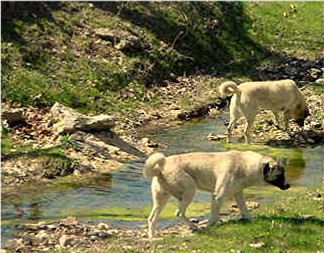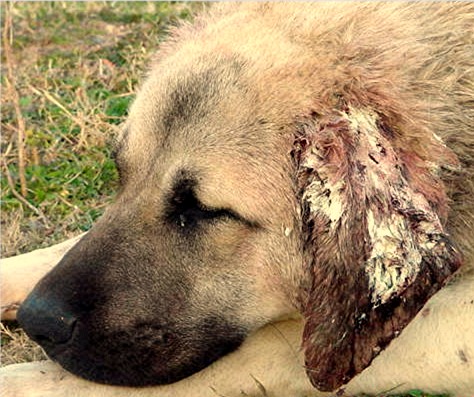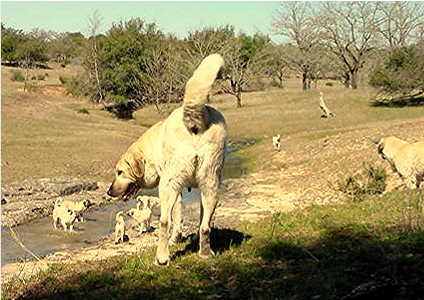Anatolian Guardian Behavior
Keeping Same Sex Intact Anatolians Together

Anatolians at Lucky Hit Ranch

 Phone Numbers Link
Phone Numbers Link
 After the third serious fight when the older males were only 8 to 9 months old, I
began to believe that I was not going to be able to keep my adult males
together. These fights were very serious and terrifying to observe.
After a certain level of intensity between the males was attained, I was completely
ignored until the dogs reached the end of their fight on their own - no matter what I
did to intervene. The third serious fight was the last actual fight they've
had. However, when the males fight all of my dogs tended to get involved!
Incredibly terrifying!
After the third serious fight when the older males were only 8 to 9 months old, I
began to believe that I was not going to be able to keep my adult males
together. These fights were very serious and terrifying to observe.
After a certain level of intensity between the males was attained, I was completely
ignored until the dogs reached the end of their fight on their own - no matter what I
did to intervene. The third serious fight was the last actual fight they've
had. However, when the males fight all of my dogs tended to get involved!
Incredibly terrifying! In late 2002 and early 2003, my "walk about" was taken with a total of eleven
dogs - ten Anatolians and a West Highland White terrier: two adult males,
three adult females, three young males (under six months old), two young females,
and an adult intact Westie female. All my Anatolians tolerate my
Westie beautifully now, but they had to learn to tolerate her and do so because
of my alpha position. One of the young male Anatolians and
one of the young female Anatolians came from other breeders and are not genetically
related to my dogs. Even though they were brought in as pups, my dogs resented these
genetically unrelated pups and it took work to get them accepted.
My alpha female was especially resentful of the young genetically unrelated
female pup and I kept them separated for several weeks (except when I was
physically present) until I felt they were safe.
In late 2002 and early 2003, my "walk about" was taken with a total of eleven
dogs - ten Anatolians and a West Highland White terrier: two adult males,
three adult females, three young males (under six months old), two young females,
and an adult intact Westie female. All my Anatolians tolerate my
Westie beautifully now, but they had to learn to tolerate her and do so because
of my alpha position. One of the young male Anatolians and
one of the young female Anatolians came from other breeders and are not genetically
related to my dogs. Even though they were brought in as pups, my dogs resented these
genetically unrelated pups and it took work to get them accepted.
My alpha female was especially resentful of the young genetically unrelated
female pup and I kept them separated for several weeks (except when I was
physically present) until I felt they were safe.|
January 2008 Update on this topic....
Ultimately I found that the closer together in age and size intact working Anatolian males are the less likely they can co-exist peacefully as equals. When they are younger and close in size and strength, it is more difficult for them to sort out which male is the dominant dog. Older working dogs seem less interested in that kind of dominance and are more focused on what it takes to keep the livestock they are protecting safe and secure. Until males of similar size and age determine which dog is truly the dominant dog, they fight. I have, however, had some success with older males being placed with much younger males because the older male quickly and clearly demonstrates that it is dominant. However, when a female comes into heat, all bets are off and deadly fights break out! In addition, some lines produce dogs that are more insistent on being the boss and refuse to be anything less. In those cases, after some serious fights there is ultimately a clear cut winner and loser and the loser is required to keep their distance and always be excessively submissive. I don't like what this does to the personality of the losing dog, so when I see this situation developing, I keep them in different pastures so each male can develop his full personality without one of them being reduced by the more dominant male. Anatolian males maintain a strict pack hierarchy similar to a wolf pack, it seems to me. They can get along much of the time but when a female comes into heat even males that have been friends engage in deadly battle. Luckily, the males I have all get along with females beautifully so I've never encountered a problem in a male-female pair. I have also worked with my females. I have managed to keep as many as five females together in the same pasture. There are some disagreements with these five females but they seem to be able to work out their problems without leaving too many holes in each other. I also feed them together in a trough. However, I am always with them when they eat and I punish any dog that growls over food by making that dog step back from the trough for one minute. With this punishment they quickly learned that growling was not a good way to get to eat! I have two other females in the pasture with the five females but I had to removed them because they were not able to get along with the other five females. I now have them with a five year old and a ten year old female. They get along with each other and the older females. So it seems that part of getting along involves the personality of each dog involved! Just like people, some dogs just don't like each other and won't get along. Make your adjustments accordingly! December 2020 update! Bottom line! I NEVER keep two intact adult males in the same pasture! There is too great a chance of severe damage (even death) between males, especially when a nearby female comes into heat!!! |
 Phone Numbers Link
Phone Numbers Link
 Click Picture to Return to Anatolian Main page
Click Picture to Return to Anatolian Main page